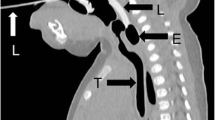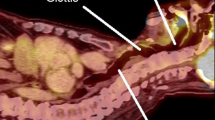Abstract
Ventilated post-mortem computed tomography (VPMCT) has been shown to achieve lung expansion in cadavers and has been proposed to enhance the diagnosis of lung pathology. Two key problems of the method of ventilation have been identified: firstly, the presence of head and neck rigor making airway insertion challenging and, secondly, air leak, if there is not a good seal around the airway, which diminishes lung expansion and causes inflation of the stomach. Simple procedures to insert a ‘definitive’ cuffed airway, which has a balloon inflated within the trachea, are therefore desirable. This study aims to test different procedures for inserting cuffed airways in cadavers and compare their ventilation efficacy and to propose a decision algorithm to select the most appropriate method. We prospectively tested variations on two ways of inserting a cuffed airway into the trachea: firstly, using an endotracheal tube (ET) approach, either blind or by direct visualisation, and, secondly, using a tracheostomy incision, either using a standard tracheostomy tube or shortened ET tube. We compare these approaches with a retrospective analysis of a previously reported series using supraglottic airways. All techniques, except ‘blind’ insertion of ET tubes, were possible with adequate placement of the airway in most cases. However, achieving both adequate insertion and a complete tracheal seal was better for definitive airways with 56 successful cases from 59 (95 %), compared with 9 cases from 18 (50 %) using supraglottic airways (p < 0.0001). Good lung expansion was achieved using all techniques if the airway was adequately positioned and achieved a good seal, and there was no significant chest pathology. We prefer inserting a shortened ET tube via a tracheostomy incision, as we find this the easiest technique to perform and train. Based on our experience, we have developed a decision algorithm to select the most appropriate method for VPMCT.






Similar content being viewed by others
References
Zaporozhan J, Ley S, Eberhardt R, Weinheimer O, Iliyushenko S, Herth F, Kauczor HU (2005) Paired inspiratory/expiratory volumetric thin-slice CT scan for emphysema analysis—comparison of different quantitative evaluations and pulmonary function test. Chest 128:3212–3220
Prosch H, Schaefer-Prokop CM, Eisenhuber E, Kienzl D, Herold CJ (2013) CT protocols in interstitial lung diseases—a survey among members of the European society of thoracic imaging and a review of the literature. Eur Radiol 23:1553–1563
Rutty GN, Brogdon G, Dedouit F, Grabherr S, Hatch GM, Jackowski C, Leth P, Persson A, Ruder TD, Shiotani S, Takahashi N, Thali MJ, Woźniak K, Yen K, Morgan B (2013) Terminology used in publications for post-mortem cross-sectional imaging. Int J Legal Med 127:465–466
Christe A, Flach P, Ross S, Spendlove D, Bolliger S, Vock P, Thali MJ (2010) Clinical radiology and postmortem imaging (Virtopsy) are not the same: specific and unspecific postmortem signs. Legal Med 12:215–222
Germerott T, Preiss US, Ebert LC, Ruder TD, Ross S, Flach PM, Ampanozi G, Filograna L, Thali MJ (2010) A new approach in virtopsy: postmortem ventilation in multislice computed tomography. Leg Med (Tokyo) 12:276–279
Germerott T, Flach PM, Preiss US, Ross SG, Thali MJ (2012) Postmortem ventilation: a new method for improved detection of pulmonary pathologies in forensic imaging. Leg Med (Tokyo) 14:223–228
Germerott T, Preiss US, Ross SG, Thali MJ, Flach PM (2013) Postmortem ventilation in cases of penetrating gunshot and stab wounds to the chest. Leg Med (Tokyo) 15:298–302
Robinson C, Biggs MJ, Amoroso J, Pakkal M, Morgan B, Rutty GN (2014) Post-mortem computed tomography ventilation; simulating breath holding. Int J Legal Med 128:139–146
Saunders SL, Amoroso J, Morgan B, Rutty G (2013) Consent of the recently bereaved to post-mortem targeted angiography research: 207 adult cases. J Clin Pathol 66:326–329
Acknowledgments
We wish to thank the relatives who gave consent for their recently departed loved ones to be part of this study. We also wish to thank H.M. Coroners’ offices for North and South Leicestershire for their support of this project, our study co-ordinator T. Visser and all the radiology and mortuary staff who supported this project.
This article presents independent research funded by the Home Office Science Secretariat, Science Group. The views expressed in this publication are those of the author(s) and not necessarily those of the Home Office.
Conflict of interest
None
Author information
Authors and Affiliations
Corresponding author
Additional information
G. N. Rutty and B. Morgan contributed equally to this work.
Rights and permissions
About this article
Cite this article
Rutty, G.N., Biggs, M.J.P., Brough, A. et al. Ventilated post-mortem computed tomography through the use of a definitive airway. Int J Legal Med 129, 325–334 (2015). https://doi.org/10.1007/s00414-014-1135-5
Received:
Accepted:
Published:
Issue Date:
DOI: https://doi.org/10.1007/s00414-014-1135-5




